Menus
- The first American superbike
- 60 ° V-Twin of 996 cm3, 135 hp and 107 Nm, 177 kg, 50 units produced
- Discovery
- In the saddle
- Test
- Conclusion
The first American superbike
60 ° V-Twin of 996 cm3, 135 hp and 107 Nm, 177 kg, 50 units produced
1995! 25 years ago! This date is a major milestone for the manufacturer Harley-Davidson for three reasons and three first times! The manufacturer passes for the first time the milestone of 100,000 motorcycles produced per year. It is also the first time that a brand model has benefited from injection, with the new Electra Glide 30th Anniversary. But it is above all the arrival of an extraordinary motorcycle in the middle of the Sportster and Fat Boy customs with a sports car and the VR 1000.
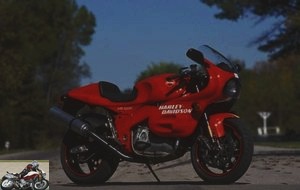 Harley-Davidson VR 1000 review
Harley-Davidson VR 1000 review
Well, we cheated a bit, the VR 1000 was actually a year ago, in 1994.
Discovery
Thus, for the very first time, it is possible to buy a Harley V-Twin a) liquid cooled, b) with an angle other than 45 ° between the two cylinders, c) new methods as the push rods to actuate the valves, d) electronic fuel injection and e) capable of exceeding the 55 mph limit then in effect in the United States on second gear.
The VR 1000 thus becomes the fastest production motorcycle ever built in the United States. And it could be yours for "only" $ 49,490 excluding taxes, a huge sum at the time, especially since you had to promise never to drive it in American streets..
But in Germany it was possible. Because this is where Harley-Davidson had its sports vehicle approved for daily use in 1993, allowing the manufacturer to return to competition in 1994. The AMA Superbike regulations did not in fact say where a motorcycle should be approved. on the road for it to be eligible, but only that it had to be somewhere in the world. That and the fact that the model had to be produced in at least 50 copies of the headlights and a license plate.
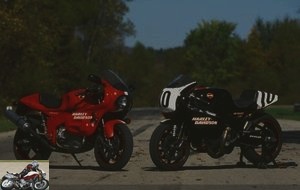 Road and factory VR 1000s
Road and factory VR 1000s
And that’s exactly what Harley did with the VR1000 which formed the basis of its commitment to AMA Superbike for the next 8 years. This is how the sportswoman competed until 2001 in the hands of pilots such as Miguel Duhamel, Doug Chandler, Chris Carr, Pascal Picotte and the former world Superbike champion Scott Russell. This allowed the manufacturer to clinch a pole position, two second places and a handful of thirds, even though there were no wins in the race..
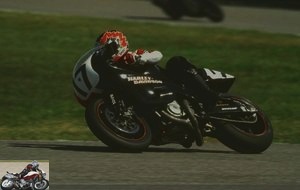 Miguel Duhamel on the Harley-Davidson VR 1000 at Daytona in 1994
Miguel Duhamel on the Harley-Davidson VR 1000 at Daytona in 1994
Starting from a blank sheet of paper when it was decided in 1987 to prepare for the Motor Company’s return to competition, Harley engineers opted for a compact 996 cc engine with two 60 ° V, 8-valve cylinders. and liquid cooling with dimensions of 98 x 66 mm, a Weber / Marelli injection and a chain transmission for driving the double overhead camshafts of each cylinder. Adapting the track to the road only required a few changes to the basic engine block. Because the Superbike just had different inlets and longer cones on the 54mm butterfly bodies, the same forged pistons but dome-shaped to offer a higher compression of 12: 1 against 10.8: 1 for the road, springs stiffer valves for higher engine speed. The stock motorcycle’s intake camshaft was used for the factory exhaust. The first thus had an even smoother exhaust shaft. The exhaust system is also different and is surprisingly quiet even when opening the throttle wide. Finally, the engine management of the Marelli Weber injection changes for a new EPROM chip.
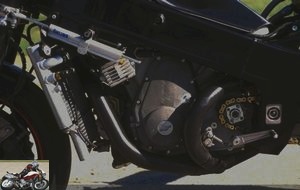 Harley upsets its habits with a 60 ° V-Twin
Harley upsets its habits with a 60 ° V-Twin
The result is a motorcycle that still develops 135 hp at 10,000 rpm and which Harley’s race director Steve Scheibe said at the time that it was mainly necessary to integrate a dry clutch and redesign the first gear to reduce the noise and allow the VR1000 to have a chance to meet standards in USA and Europe.
Being liquid cooled, the engine is quite quiet in operation, except in first gear even if the air filter that we adapt effectively reduces the intake noise. It wouldn’t be difficult to sanitize this engine enough to make it EPA compliant..
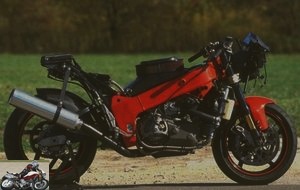 The VR1000 is based on an aluminum perimeter frame
The VR1000 is based on an aluminum perimeter frame
In that case, one might wonder why Harley didn’t do it? Perhaps for the same reason that despite pressure from enthusiasts around the world, Ducati ultimately refused to make a homologated version of its magnificent Supermono built in just as limited numbers as the Harley VR of the same era..
Like Ducati, Harley had done all the difficult and expensive operations on the RV: they’d designed the basic design, put it down on paper, made molds for all the engine parts and then made them, did the same. for glass or carbon fiber cladding. They built, developed, tested and rode the bike, thus stimulating the interest of a certain segment of Harley enthusiasts (and, more importantly, non-Harleys) in purchasing a road version, but frankly. not at $ 49,490 excluding taxes. Some Ducati management figures doubted there was a market for a homologated single cylinder that would cost more than a V-Twin 900SS. And even if that would be the case, they could not meet the demand for their existing V-Twins, particularly the famous 916 and thus preferred not to take any risks..
This is precisely the same thing that happened for Harley-Davidson and the VR1000: Until the thinking heads of Milwaukee are convinced of the viability of the VR in terms of sales volumes AND the additional capabilities to produce it. , the first American superbike would remain a special homologation in 50 copies. Moreover, with the annual production of 100,000 motorcycles, as the wave of customer demand for its traditional pushrod models began to climb to the peak of 330,619 units in 2017, there was no need to shy away from the primary focus of the brand and to leave its core target by expanding into other segments such as Superbike.
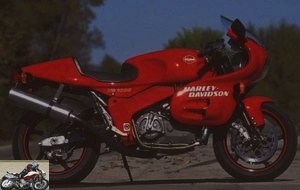 Harley-Davidson asking no less than $ 50,000 for VR 1000
Harley-Davidson asking no less than $ 50,000 for VR 1000
The twin-cam engine of this little-known machine actually served as the basis for the development of the similar block developed by Porsche for the V-Rod which debuted in 2002. Although the VR1000s were sold worldwide, United States to Japan via Australia, United Kingdom, Germany and other havens for road sportsmen, they remain today a spectacle in themselves. Was a VR1000 worth making space in the garage for it for anything other than its rarity rating, even assuming you could afford your admission ticket? A 400 mile route on Wisconsin country roads that included an outing on Harley’s Blackhawk Farms test track and ending with a stretch of freeway to Milwaukee headquarters at absolutely un-American speeds, m ‘ allowed to get to the bottom of it, with a few surprises.
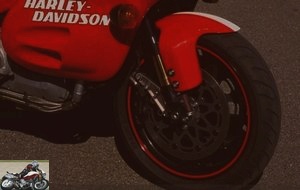 At the front we find an inverted Цhlins fork and two Wilwood six-piston calipers
At the front we find an inverted Цhlins fork and two Wilwood six-piston calipers
One of them was that such a motorcycle actually existed on American roads! When you know the EPA’s so strict and ubiquitous regulations, you wonder how this was possible. Harley may have asked one of her employees returning from Germany to send her one for Christmas. I’m glad they did! Otherwise I might never have discovered that it was indeed possible to produce a sporty, fuel-injected V-Twin, offering fun and functional performance, elsewhere than in Bologna in 1994. Despite its track heritage, let’s face it. It was still a special homologation taking the form of a superbike with headlights, like a Ducati 916SP or a Honda RC45. But the Harley turned out to be perfectly serviceable for everyday driving, pulling cleanly from 56 km / h in fifth gear, but halfway through the red zone of 10,400 rpm at just 130 km / h. The bike could easily exceed 250 km / h but also be comfortable in town at 3,000-3,500 rpm in heavy traffic. But just show him an open road with no radar, twist your wrist and brace yourself to enjoy the ride !
In the saddle
That’s what I did, really. The VR offers a good riding position, with a higher handlebar than on the race bike thanks to the identical Ohlins inverted fork but lowered into the upper triple triple clamp, allowing the straps to be attached above. We feel less perched on the Harley. We are more part of the bike unlike the contemporary Ducati 916 to which the American was inevitably compared. The unusually shaped bubble offers good protection at almost any speed. Sitting, it deflects a large part of the wind, but by lying down a little it provides an envelope to retract its head and offers more protection at high speed than the small bubble of the 916 and that without having to stick to the tank as on the Italian. On the road, the racing saddle turns into a wooden plank after 160 km, but anyway you have to stop to refuel, especially if you have driven hard. And the temptation to do so is real! Because the VR delivers great performance, more than any other motorcycle ever made in Milwaukee until then and in a more lively way than most Japanese women of the time..
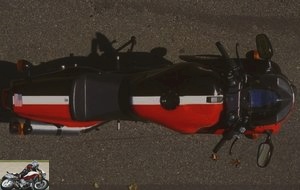 The riding position is more comfortable than on the Factory, but the saddle remains hard
The riding position is more comfortable than on the Factory, but the saddle remains hard
You have to turn the ignition key with one click to the right, then with a second click to turn on the headlight and finally be able to press the starter and prepare to be seduced..
The VR1000’s engine sound has a unique character! Despite its racing heritage, it instantly starts cold, then settles into idle with a hoarse growl as the EFI Marelli’s auto-choke derived from the car helps warm it up, amid a rattling of clutch discs. No other road engine of the time, in those days before the Aprilia RSV1000 arrived, had that unique VR exhaust sound that was even slightly louder than that of a Ducati. There is virtually no vibration thanks to the counter balancer which eliminates unwanted tingling without the need to use thicker, heavier rubber motor mounts or boards.
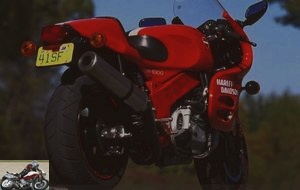 The sound of the VR1000 is reminiscent of that of Italian sports cars of the time
The sound of the VR1000 is reminiscent of that of Italian sports cars of the time
Twist the grip and watch the revs quickly rise on the large analog speedometer. The factory race bike had a slightly faster revving, but the greater inertia of the VR allows it to gain torque and especially in handling in real driving conditions..
If the absence of sixth gear was an indisputable handicap on the circuit, this is no longer the case on the road. The state-of-the-art digital counter (for the time) under the tachometer allows you to scroll through the three pages of data using the turn signal switch on the left of the handlebars. The first page gives the speed in mph, the total mileage and a partial. Page 2 displays oil pressure and temperature as well as speed. Finally, the third gives the temperature of the water, the battery charge and … the speed. The whole remains readable even under a bright sun, unlike the digital instrumentation of the Bimota Tesi released four years earlier.
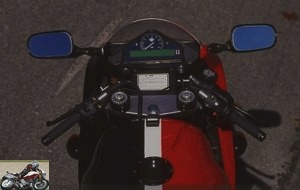 Instrumentation includes analog tachometer and digital counter
Instrumentation includes analog tachometer and digital counter
Test
On the highway, the VR keeps its promises: by mid-90s standards. It is a truly exceptional sports bike that compares favorably in dynamic terms to anything then produced in Italy by Tamburini and Bordi, except look level…
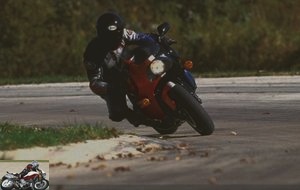 The VR1000 screen offers good protection
The VR1000 screen offers good protection
The Harley’s GP-style aluminum alloy perimeter frame created by former British GP designer Mike Eatough with the help of chassis specialist Harris Performance provides quality handling comparable to the Ducati reference 916, after that Tamburini had solved the initial instability problem by lengthening the single-sided swingarm by 25 mm. The short 1,410mm wheelbase enabled by the more compact HD engine provides agility that makes taking the VR1000 through fast virolos like a breeze. In fact, this bike loves winding roads, as evidenced by its good results on twisty tracks in Mid-Ohio or Pikes Peak. The well-balanced steering geometry (24 ° angle, 90mm drag) provides stability while maintaining crisp steering. The VR changes direction effortlessly at high speed due to the compactness of the V-Twin’s masses at 60 °. However, it remains very stable in fast curves and braking and handles passages over bumps well thanks to its low center of gravity and the tuning of well-adjusted Ohlins suspensions..
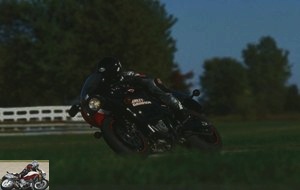 Quite compact, the VR 1000 is particularly at home on winding roads.
Quite compact, the VR 1000 is particularly at home on winding roads.
But while the Wilwood six-piston front brakes performed brilliantly on the racetrack, they prove disappointing on the road. They totally lack bite and don’t have as much feeling. They also require a strong pressure of the lever to function correctly, even if they bite well once warmed up. A change of pads to something more suitable for the road would most likely have corrected the problem..
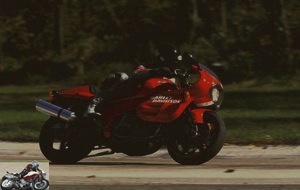 On the other hand, the braking of the Harley is more suited to the circuit than to the road.
On the other hand, the braking of the Harley is more suited to the circuit than to the road.
Paradoxically, it is the same attributes that have kept it from putting its mark on the competition in AMA Superbike that make the VR1000 a remarkable road bike. All road rvs were built to early 1994 AMA Superbike specifications, representing the basis for the factory team. But the sporty Harley was not a Ducati. It didn’t have the explosive acceleration of the Desmo V-Twin, nor its appetite for high revs or its close six-speed gearbox that allowed full use of power in the revs. What the VR1000 had instead is more suitable for the road with a linear power delivery from 3,000 rpm and a torque curve that peaks at 107 Nm at 8,000 rpm but remains practically flat throughout. the speed range. This results in a punchy and manoeuvrable bike with a relatively long five-speed gearbox that favors the torquey nature of the RV. However, don’t think that this is some kind of boosted SuperGlide, as a face-to-face by an American magazine at the time showed that the VR1000 outclassed the Honda CBR900 Fireblade, too. well launched at 80 km / h than at a standing start! Who would have seen Harley beat Honda in the field of sportsmanship? ?!
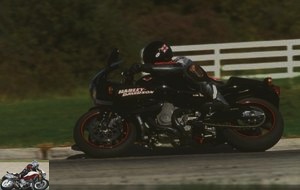 The V-twin here develops 135 hp and 107 Nm of torque
The V-twin here develops 135 hp and 107 Nm of torque
Conclusion
In a way, the VR1000 represented Harley’s management assurance for the future to avoid ending up with its back to the wall when demand for traditional models plummeted under bureaucratic pressure or change. fashion, two capricious factors against which it is intelligent to guard against. This is also why they developed the V-Rod using the engine platform of the VR1000 rather than putting it into series production at an affordable price. And it’s a shame because the VR1000 was a very good road bike, despite its contested look and its odd paintwork that we owe to none other than Willie G. Davidson. Imagine if Harley management had hired Supermono designer Pierre Terblanche, who was then a freelance consultant, to embellish the VR 1000 ?! After riding it I think they had a bestseller potential in their hands, especially lowering that astronomical price tag to make it comparable to a Ducati 916 in terms of price and performance. And who knows, with continued serious investment, the VR1000 could have performed better in the race and ended up higher in the history books of the HOG loyalists..
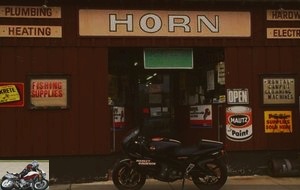 Only 50 examples of the Harley-Davidson VR 1000 will have finally seen the light of day, too bad…
Only 50 examples of the Harley-Davidson VR 1000 will have finally seen the light of day, too bad…
But none of this happened. The creation of the first American superbike, the Harley-Davidson VR1000, remains one of the most important missed opportunities. Erik Buell’s eponymous company became a subsidiary of Harley in 1993, when the VR1000 was about to make its racing debut. Buell has responded to the desire of the Harley leadership by producing an original line of sport bikes equipped with an evolved version of HD’s traditional pushrod engine which they believe would not offend their established clientele if seen in the back of the engine. ‘a Harley dealership. Too bad the VR1000 package never ended with Erik, although he himself designed a chassis for the bike which, for reasons still unclear, was not chosen for use on the race bike. Another missed opportunity !
Strong points
- Motor
- Cycle part
- Agility
- Protection
Weak points
- Braking
- Price
The technical sheet of the Harley-Davidson VR 1000
Related articles
-
Biker test: R-One All the world dreams of one day finding THE motorcycle. The one who changes life in the absence of the world, which retraces the roads,…
-
Triumph Daytona 955i motorcycle test
Centenial Edition – English elegance GSX-R1000, R1, CBR 900 … There are the hyper-sports which are always on the front of the stage and then there are…
-
Curtiss P40 Warhawk Final Edition motorcycle test
First and last 2.163 cc V-Twin, 156 hp and 217 Nm, 247 kg full made, $ 75,000 Curtiss Motorcycle Co. , named after legendary American biker and aviation…
-
Ducati 350 SCD motorcycle test
From the circuit to the road for the Italian sportswoman 4-stroke single cylinder, 340 cc, 42 hp, 210 km / h, 112 kg dry In 1954, the arrival of Fabio…
-
The unfinished future The brand with three tuning forks, wishing to prove its lead in terms of technology and innovation, unveiled its 1000 GTS at the…
-
Royal Enfiel RE350 Brass Rajah motorcycle test
The Indian Bobber King of Brass 346 cc single cylinder, 19.8 hp, 28 Nm, 155 kg dry The customization of motorcycles has known for a decade a continuous…
-
Biker test: Slow Philou At the house of Ducati, ST stands for Sport-Touring. The motorcycle was released in 1997 and has since that on points of detail,…
-
Laverda 915 SFC motorcycle test
Post-classic queen 915 cc parallel-twin, 90 hp, steel subframe, 167 kg It’s been 20 years since the last Laverda left the brand’s factories, but the…
-
Harley-Davidson LiveWire electric motorcycle test
0 – 100 km / h in 3 seconds … Revolution… Revelation electric motor, 105 hp and 116.6 Nm, 249 kg, adjustable Showa suspensions, 150 km of range, from…
-
Harley-Davidson Sport Glide 107 Test
Touring and sport at the same time: absolute versatility according to Harley V2, 1745 cm3, 84 hp at 5400 rpm, 145 Nm at 3250 rpm, 304 dry kilos, from €…
Sometimes the beauty is inside !
(and then, to be gone on vacation with, she still has a real power of seduction with onlookers)
Philippe
I like it 🙂
After tastes and colors …
Instead of the S20 I would have rather seen the T30.
The T30 is more road. The S20 will appeal to the most athletic.
This is the dimension that seems too important to me. But a more arched tire profile should improve things (like metzler roadtech Z8 interact …)
no, I insist, d-s-u-e-t !
And much more in braking and cycle part than in engine.

I admit that it happened to me…
You should find traces of it in the Harley trials.
No kidding ?
It must be my schizophrenic side then. I will talk about it to my Motobecane, Terrot, R80 and other BSA.
At HD, the Twin Cam Screamin’Eagle 110 (stage 2) is surely their most successful engine..
Which in no way prevents global obsolescence.
Moreover, an Indian is incomparably better in every way, as well as the Royal Enfield 650. All at correct or identical prices for one, totally affordable for the other..
And to choose, an XV 1900 Midnight Star would be my custom. Yeah, a Yam ‘ !
As for finding modern production sanitized, and even if it means advising testing before speaking, a ride in Streetfighter V4, Nine T (first generation) or other KTM 690/790 should give you ideas.
In the meantime, I am looking for a 900 SS 1991, semi-faired.
You have a morale of steel?
You have the means?
Good luck.
– Well yes.
– Uh no…
– … Thank you (?)
It’s still cheaper than a 1978 SS
A 4/1 Akrapovič NH would make it lose 10kg and gain 10hp (and as many Nm of torque)

It’s already taken
excellent article which allows to realize the evolutions of this sport road. after a half hour trial I ordered one (tourer version 2018) which I hope will be ready next week
My daughter, six feet tall, has a crush on her, but the saddle is too high for her feet to touch the ground. I recommended him the 400 or a 500 CB.
Difficult choice when you are a woman to choose a motorcycle and I do not even speak of the trails.
Many do not like neo retro
The z400 is very nice! I tried it and I put my feet on the ground despite my 1.60m
@Picibia: Ask at a dealership, but it seems to me that the Z650 is available in two heights. I myself have a low version of 2019 and I was not even aware at the time of purchase.
It surprised me the difference by comparing with that of another biker, there must be around 2 cm of difference.